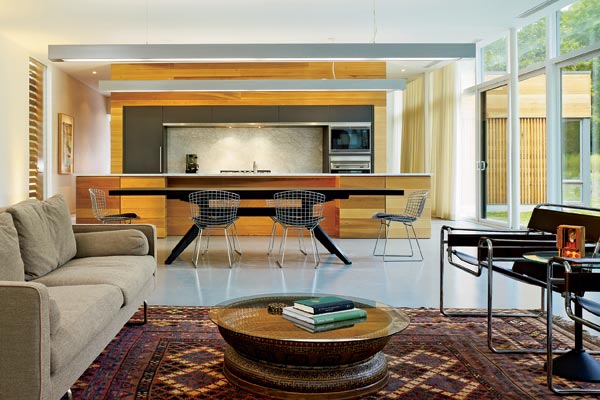
Because the back of the house faces the woods, the homeowners rarely need to draw curtains. Photo Gallery »
SIZE: 2,700 sq. ft.
TYPE: Single-family
LOCATION: Michigan City, Indiana
When Jim and Sara Coffou decided three years ago to build a home on the two-acre plot of land they’d bought in Michigan City, Indiana, their motivation was not long walks through the countryside. “We’re not nature people,” Jim says flatly. “We were in it for the house.” Both lifelong architecture, design, and modern-art buffs, the couple had always wanted to build their own modern house—and they’d envisioned it standing alone on a prairie, surrounded by open land. A sort of Farnsworth House, denuded of its protective forest.
After a few weeks of searching for just the right architect, the Coffous went with Brad Lynch, of Brininstool + Lynch, falling for his style “hook, line, and sinker,” says Jim. On the firm’s Web site, the couple saw a house located in Peru, Illinois, with the same sort of wood-slatted “rain screen” that now makes up the façade of their home. Lynch came up with this concept years ago while driving through the countryside and observing old barns and corn cribs, many of them clad in horizontal wood siding. He created his own version of this look out of slats of red cedar, giving typical modernist structures a hint of country.
But the screen on the Indiana house is not just an homage to agrarian architecture. It serves two practical functions. The first is that it gives the façade of the home, which can be seen from the road, a sheath of privacy. The second is that the open slats that extend over the enclosed porch temper the wind that comes in off Lake Michigan. As for tempering those Midwest mosquitoes, the open slats are backed with an insect screen.
Photography: Christopher Barrett/Hedrich Blessing
Related:

The Arclinea kitchen is finished in the same red cedar that lines the seating nook across from the fireplace (below). Photo Gallery »
Inside, the L-shaped house is divided into two distinct parts: public and private. The long side of the L contains the kitchen and dining/living area, as well as the enclosed porch, which is separated from the indoor space by retractable glass doors that can be fully opened in the summer, welcoming that perfectly honed breeze inside. The south wall is made up almost entirely of floor-to-ceiling windows, 60 percent of which are operable, allowing virtually the entire living area to be open to the outdoors in good weather.
The glass has another purpose. “In wintertime, the sun hits the concrete floor, so we’re using a passive solar technique to supplement the radiant heating system in the floor,” says Lynch. Conversely, he designed an overhang on the exterior of that wall so that the summer sun doesn’t bake.
The south side of the house also includes the short leg of the L, which contains three modest bedrooms and their respective baths —the private quarters. Connecting the two parts of the house is the entryway, which doubles as a hearth/reading nook. Odd, you might say, to have the fireplace here. And that was the Coffous’ first reaction, as well, until their architect made some convincing arguments.
“The house is about the view,” he says. “We didn’t want the fireplace to be a distraction. Oftentimes, the TV goes near the fireplace, and then it turns into: Are you watching TV? Are you looking at the fireplace? Or are you looking at the view? Everybody wants everything at once, but the reality is, to really enjoy the fireplace, it needed to be on its own.”
Lynch zeroed in on what his clients wanted: to be able to curl up with a good book near the fire. So he designed a red-cedar-clad recessed nook containing a built-in daybed across from a fireplace . . . in the hallway. Lynch can’t accept full credit for his unconventional solution; inglenooks are, after all, a centuries-old idea. “Frank Lloyd Wright used to do it in his older Prairie-school homes,” he says. “He’d isolate the fireplace with seating on both sides in an area off the main parlor. It’s taking that idea and modernizing it.”
The Coffous, who have two grown daughters, are now converts, too. “On chilly nights, all four of us cuddle there,” says Jim.
Photography: Christopher Barrett/Hedrich Blessing
Related:

The Coffous love to entertain year-round. When the weather is nice, they can open the sliding doors and feel as if they are outside. Photo Gallery »
Beyond that cushioned nook, the 2,700-square-foot space is sparsely but thoughtfully furnished. The basics are there: a big dining table with Bertoia chairs, a sofa and two Marcel Breuer Wassily chairs in the living room (and a similar set-up on the porch, with furniture Sara’s parents had bought in 1948 for their own summer cottage), a Le Corbusier chaise, and a coffee table that Sara fashioned from a huge antique Chinese basket and a glass top. No accouterments or accessories to speak of. None of that typical second-home bric-a-brac.
“That’s modernism,” Jim says of the austerity. And then there’s the fact that when you’ve got a view like this one, you don’t need much else.
Architect: Brininstool + Lynch, 230 W. Superior St., 312-640-0505; brininstool-lynch.com. General contractor: Mulcahy Builders, Michigan City, Indiana, 219-241-1020. Living room: Wassily chairs and LC4 chaise, Design Within Reach, dwr.com. Rug, Rouzati Oriental Rugs, 1901 Central St., Evanston, 847-328-0000. Kitchen: Arclinea, 314 W. Superior St., 312-335-3855. Stove, KitchenAid; refrigerator, SubZero, both at Abt, 1200 N. Milwaukee Ave., Glenview, 847-967-8830. Dining area: Table, Cross Extension by Matthew Hilton, and Bertoia chairs, Design Within Reach.
Photography: Christopher Barrett/Hedrich Blessing
Related:



